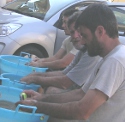Pauli Stincus - fieldwork 2010
 |
Fieldwork at the site of Pauli Stincus began on Tuesday 22 June 2010. The excavation team was made up of doctoral students, postdoc researchers and staff associated with the universities of Valencia and Glasgow as well as local volunteers. Work began by mechanically stripping the topsoil that had regularly been ploughed over the years. Numerous archaeological features were brought to light over an area of about 30x10 m. |
Project Links
Other Links
Press Reports in
(both in Italian)

The most obvious and consistent features were relatively short stretches of wall, which represent the lower stone-built bases of what presumably were mud-brick walls. Although in one instance a well-built corner has been preserved, ploughing in recent decades has removed many of the stones and all that has been left is a dark-coloured trench in which the stones had originally been placed. After a week of carefully cleaning and excavating the soil features, it gradually became clear that we were dealing with two distinct building phases or rather two different buildings that had occupied this site at separate but subsequent moments in time. Because both buildings continued under the spoil heap, the trench was extended until right at the edge of the field.
This field boundary must have been a long-established one that had never been ploughed, as it revealed a wall base of some 3 m long that was preserved remarkably well. Against it, two floor levels and floor preparations could also be distinguished. |
|

 |
Other notable features are a series of pits that had been dug as rubbish deposit. These pits contain large numbers of finds, most of which is pottery sherds (several thousands), and smaller quantities of bone, molluscs and metal. |

Both on site and in the lab much time is spent on documenting the fieldwork and cleaning and recording the numerous finds.
|
From 1 July, the archaeological team was joined by two geomorphologists (Pilar Carmona and José Miquel Pérez from Valencia) and two soil scientists (Cristiano Nicosia from Milano/Vicenza and Roger Langohr from Gent). They investigated the immediate and wider physical environment of the Terralba district and their preliminary results include the identification of several ancient land surfaces that show traces of agricultural activities datable to the Punic period.

In all, a picture has emerged of a rural settlement, where people lived and worked for several centuries. In the course of about 250 years of occupation, the original building was completely replaced at one point by a new and somewhat bigger house that is likely to have boasted two floors.
Fieldwork finished on Tuesday 5 July 2010, while work on the finds inventory continued for another couple of days until Thursday 8 July.
(updated 10 July 2010)







